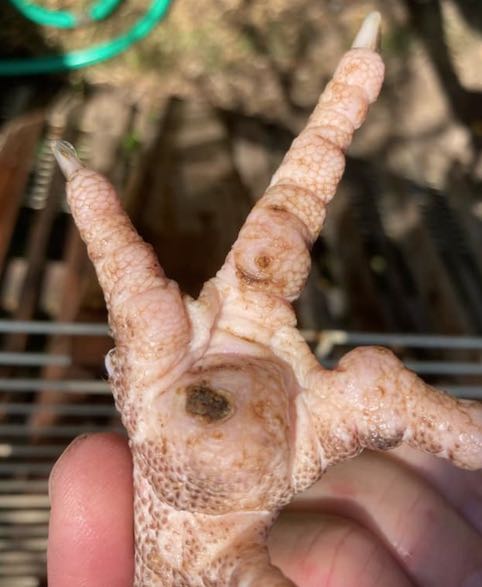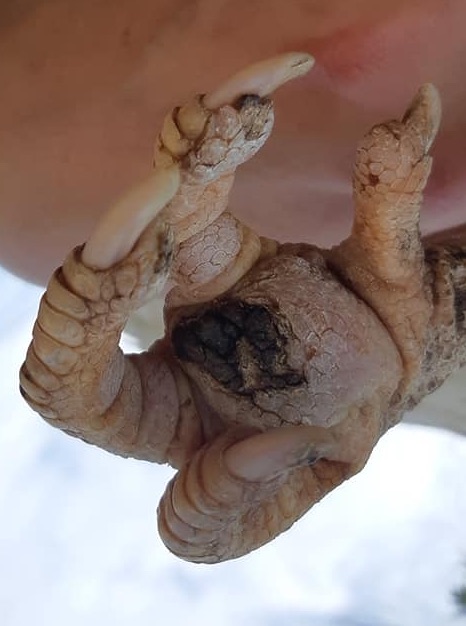A bumblefoot is an infection in your chicken’s foot. We’re going to detail how to discover it, how to treat it, and how it can be prevented.
What is Bumblefoot?
Simply put, Bumblefoot is an infection (a staph infection) in your chickens foot. The infection can present in one, or both feet, and is not contagious to other chickens.

How often does it happens?
If ever there is a sure thing about owning chickens, aside from the reality of chicken math … it’s this:
You will, at some point, come face to face with Bumblefoot in your backyard flock.
It is a guarantee.
And, because you can rest assured that you will have to deal with it, it’s best to be prepared (mentally and physically).
Now, Bumblefoot can become serious, and even life threatening for a chicken, BUT, there is no need to panic! Bumblefoot is treatable and – better yet – preventable. In this article we will discuss a couple of treatment options, because – like I said – Bumblefoot is bound to happen at some point in raising your backyard flock.

How Do You Know if Your Chicken has Bumblefoot?
There are a few tell tale characteristics in identifying Bumblefoot:
● Red and swollen foot or between the toes
● Brown or black scab on the underside of the foot
● Limping
How Do They Get It?
You know the saying, the best defence is a good offence. Well, that is mostly true when it comes to managing Bumblefoot. However, as many chicken tenders know, even with the best preventative measures, chickens are bird brains and they can find a way to become injured or die even with the best of care.
Ask me sometime about my first tragic year owning hens and the leagues of learning I did trying to manage the flock.
That being said, Bumblefoot occurs when an injury gets dirty and then the infection sets in before the chicken has a chance to heal. The injury could be something as simple as a sliver that took in bacteria from the coop and BAM, Bumblefoot.
The most common culprits are:
● Cuts and scrapes from wood shaving bedding
● Splintered roosts
● Heavy landings (not all chickens are graceful, I have a large brahma and she’s pretty but she descends from her roost with as much grace as a newborn giraffe).
The most common cause comes alas from routine
The most common cause, in my experience, is routine scratching and foraging. They come by these injuries honestly and, like I said before, no matter how hard you try to avoid it, cuts and scrapes happen.
Now that they have an injury it’s just a matter of time before they step in a fresh pile of chicken poop and there you have it, the perfect set for Bumblefoot.
No matter what caused it, it is important to treat Bumblefoot quickly and effectively. Not only does the infection spread for your chicken (it can spread to the bones and cause permanent damage and significant pain) but it is also contagious and, if you think the coming description of removal is bad for ONE bird, imagine your entire flock!
Let’s Talk Prevention
An ounce of prevention is worth a pound of cure. And in the case of Bumblefoot, unless you intend to open up a veterinary side hustle after performing roadside surgery on your flock, it’s best to learn the ropes of managing the “risks”.
● The easiest thing to do is clean your coop regularly.
● Check roosting bars for splinters and cracks that could injure your birds.
● If you have heavy ladies in your coop, consider lowering your roosts to avoid injury.
● Examine your flocks feet on a regular basis (detecting injury and treating for possible infection early is far easier, cheaper, and less stressful than treating a set in infection).
● Ensure adequate diet (lack of vitamins or obesity can contribute to injuries that allow Bumblefoot to set in).
**It is important to remember, as you check your hens feet, do not panic at the sight of a cut, not every injury will result in Bumblefoot. In fact, most won’t and that’s likely due to the fact that you are a mindful owner and you are implementing the above expertly! Good on ya!
Treating Bumblefoot
If you’ve been reading along and picked up on the most common treatment for Bumblefoot you’ll know that we are about to talk Chicken ER. That’s right, you are about to become a chicken surgeon.
Please note: this is NOT veterinary advice! I am not a licensed veterinarian nor a medical professional. This advice and treatment is based on my own experience and research as a backyard chicken tender (ok, if you haven’t chuckled at my chicken tender joke we can’t be friends ;). Please understand that this is not a sure fire suggestion and there is risk of injury to yourself and your bird (even the possibility of death). Implement at your own risk.
– Cassandra
Mild Cases Of Bumblefoot (Early Detection)
In mild cases of Bumblefoot, when you are able to catch it before the black spot appears, you can treat effectively with cleaning and over the counter antiseptic (I clean with Dawn and an Epson Salt soak, then I apply coconut oil and a drop of tea tree oil). Cleaning daily and wrapping in vet wrap should alleviate the pain and treat the infection as to not require surgery.
Severe Bumblefoot
It may come to pass that you haven’t noticed the cut on your hens foot and on a regular trip to the coop you notice a hen limping or appearing “lame”, upon closer inspection you notice the scab.
It’s ok.
Breathe.
While you can always bring your hen to a local expert in avian care, it’s an expensive endeavour and I am confident that this is something you can manage at home.
What you need:
● Scalpel
● Biopsy Punch
● Polysporin – note : do not use the numbing type, it’s toxic for chickens. Only the regular one.
● Tweezers
● Disposable Gloves
● Non-stick Gauze
● Vetwrap
Let’s Talk Surgery
I’ll come right out and say it, Bumblefoot surgery is not for the faint of heart (is any surgery really?) and, while you can manage this procedure solo, it is easier with two people. Many hands make light work after all.
You will also want to make sure that you have time to do this procedure and that you aren’t opting to try this out when there are pressing deadlines or it’s coming up to the middle of the night (not saying I’ve ever made a rash decision like that before …) You will want to give yourself at least an hour to adequately treat this infection and breathe through it.
Now, I’m going to tell you this now and I want you to remember it when the time comes that you feel that first surge of adrenaline as you get ready to cut.
Breathe.
Calm yourself.
Think through what your plan of approach is and remember that this is painful for the bird, they will struggle (this is where having an extra set of hands is important) and there is going to be blood. This isn’t some sterilized Dr. Pimple Popper extraction where they are cauterizing the wound or injecting solution to prevent bleeding. This is surgery, on an animal, and the feet bleed a fair amount.
So, be warned.
Preparation
Before you begin, many people may cringe at my coming suggestion BUT … I perform this in my kitchen sink and here’s why:
There is a lot of lighting in my kitchen, running water, a big basin (the sink) for the soak and the clean-up, and I am comfortable working in my kitchen in a high stress situation (cooking Thanksgiving dinner for 30 anyone).
Clean your sink thoroughly before AND AFTER this procedure. You don’t want to introduce new bacteria into the wound because you left dinner scraps in the sink before preparing your soak.
Before bringing your hen in you want to make sure you are set up for success. Run the epson soak, lay out your surgery tools, have towels and paper towel on hand, and set up a “dressing” station with your gauze, Poly and your vet wrap.
The more prepared you are the less chaotic it will be.
Soak
In a warm epson salt bath, you are going to want soak your hens foot for at least 20 minutes. You want to soak the foot enough that the scab is easy to remove.
After you soak and before you get ready to cut, cover your hens head with a towel to avoid stressing her any further.
Then, gently rub the scab with your gloved nail or brush it with the scalpel to see if the scab comes off. Some (infrequently, but not impossible) cases of Bumblefoot can be treated with little evasiveness and simply applying an antiseptic like Poly to the wound.
IF the scab does not come off easily, or you remove the spot and there is underlying infection, you need to proceed with removal of the kernel (the full infection).
Time for Surgery
There are two ways to approach this surgery, scalpel or biopsy punch.
If you have a steady hand and are comfortable applying some pressure (probably more than your initial hesitant “slice”) than I would suggest a scalpel. They are more precise and therefore result in less “loss” of tissue.
If you are less certain with your handiwork, or you are reasonably concerned that you may faint, a biopsy punch is a fantastic tool and getting the job done.
The main goal is to cut around the spot (the scab) and remove the abscessed (hardened part) infection in the birds foot. This abscess is commonly called the “kernel” or the “plug” and is caused by a cumulation of dead tissue and puss being trapped in the foot.
Using the scalpel, you will want to cut away the dead tissue from the live and healthy. Gently excising the infection until you are able to remove the mostly solid mass (note: mid-detection of Bumblefoot may mean that the kernel is not truly solid and resembles stringy or slippery infection, this you can remove using tweezers).
If you are using the biopsy punch, you want to make sure the punch is centred around the scab, the goal is to surround the infection with the blade of your tool. With some pressure, slowly twist the punch to core the kernel and remove the infection (think of the biopsy punch like an apple corer). This is the “easier” way to remove Bumblefoot, but it does result in a greater amount of tissue loss and is less precise than a scalpel.
As you remove the tissue it may be handy to have a syringe nearby with saline (salt) water, to clean the foot so you can see what you’re doing.
Don’t forget to breathe
It is unlikely you’ve ever done something like this. Seeing blood, wielding a knife of some sorts, and having a live animal struggle under your armpit, is enough to trouble even the most stoic of backyard farmers.
Breathe.
Breathing allows you to think and process the situation with logic as opposed to emotion. You need to be logical and follow through with this because, as difficult as it is, there is nothing worse than starting this procedure and backing out because you got scared or intimidated.
As intimidating as this is, timely and effective removal is important for the health of your chicken. Bumblefoot will eventually lead to paralysis or death, this is hard but necessary. You can do this!
Now, you may not be able to remove the full kernel in one stab at it (horrible pun intended).
If the kernel is too difficult to remove because it is deep set in the foot, soak the chickens foot again in a clean sink and repeat the process.
Do this until you can see fresh and bleeding skin in the wound.
It is important to remove the full kernel and infection because leaving any behind increases the risk of reinfection in your hen.
Wrap it and Tend to It
Once the kernel is removed, you will want to soak the foot again (in a clean epson salt bath) and apply your antiseptic cream before wrapping.
2-3 times a day (at least once) you will want to reapply your antiseptic cream and change the wrap, this will allow you to monitor the infection and ensure timely response should you notice a reoccurrence (for the first 48 hours).
After the first couple of days, you will want to keep the foot wrapped for 7-10 days, changing the bandage every 2 days or as needed if you have a dirty bird.
Despite what I said above, that chickens will find a way to get hurt, they are resilient creatures and, if you’ve done a solid job removing the infection, your hen will likely make a pretty awesome recovery in a matter of days.
Conclusion
Bumblefoot is very likely to occur, but fortunately, is quite easy to detect. You can try to treat it yourself, but if it is too severe, it’s time for surgery – done by yourself, or thanks to a veterinarian.




